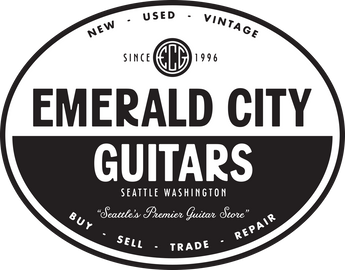








1954 Fender Stratocaster
An incredible first-year Fender Stratocaster featuring a "10-54" body date and a Tadeo Gomez "12-54" neck date with pots dating to the 35th week of 1954. This Strat looks stunning with a killer worn-in aesthetic - A true testament to quality instruments that sound great and play great. The neck feels fantastic with an ergonomic slight-V contour that feels really natural and plays wonderfully with a replaced nut and a fresh re-fret. Like many of these early examples, the neck PU has slowly faded away but we decided to keep it in its original state and leave it to the new owner to decide what to do with it. Other modifications are slight with replaced PU covers, a replaced switch tip, replaced saddle screws, and a small finish touch-up on the back. This is an amazing first-year example! Comes with a non-original hardshell case.
Check out the feature from our luthier Tyler in the ECG Newsletter:
"It’s no secret that a first-year Strat is about the closest thing you can get to a blue-chip stock with strings. For the most part, these things live in fireproof safes, bank vaults, and occasionally behind glass at one of the few top vintage guitar shops in the world. (We currently have 3 in stock, but who’s keeping score?) The ’54 Strat’s holy-grail status typically means they’re handled with kid gloves, which makes this heavily played example all the cooler. 7 decades of hard, honest wear are apparent throughout. The original pickup covers have long since been worn through and replaced. Hundreds of sweaty gigs rusted the original saddle screws to a point of uselessness, new screws were sourced. The original nut and frets bit the dust sometime during Gerald Ford’s presidency. Whoever owned this guitar simply never got the “holy grail” memo, and I wouldn’t have it any other way.
Fender VP Forrest White insisted that all Stratocasters produced before October 13th, 1954 were either artist models, or what he called “pre-production samples.” That puts this particular instrument right on the cusp and shows features typical of both pre and post-production Stratocasters. As the name suggests, these samples were either shipped to prominent musicians or sent to music stores to be used in demonstrations. It’s widely accepted that these early models were made mostly by hand, and accordingly, inconsistencies abound. The headstock shape, contours, and neck transitions each show subtle differences reflecting the tastes of whoever shaped them. As production grew, though, these eccentricities slowly evaporated. Cliches become cliches by being true, and such is the case when I say that no vintage guitar collection is truly complete without a 1954 Stratocaster." - Tyler Geske









